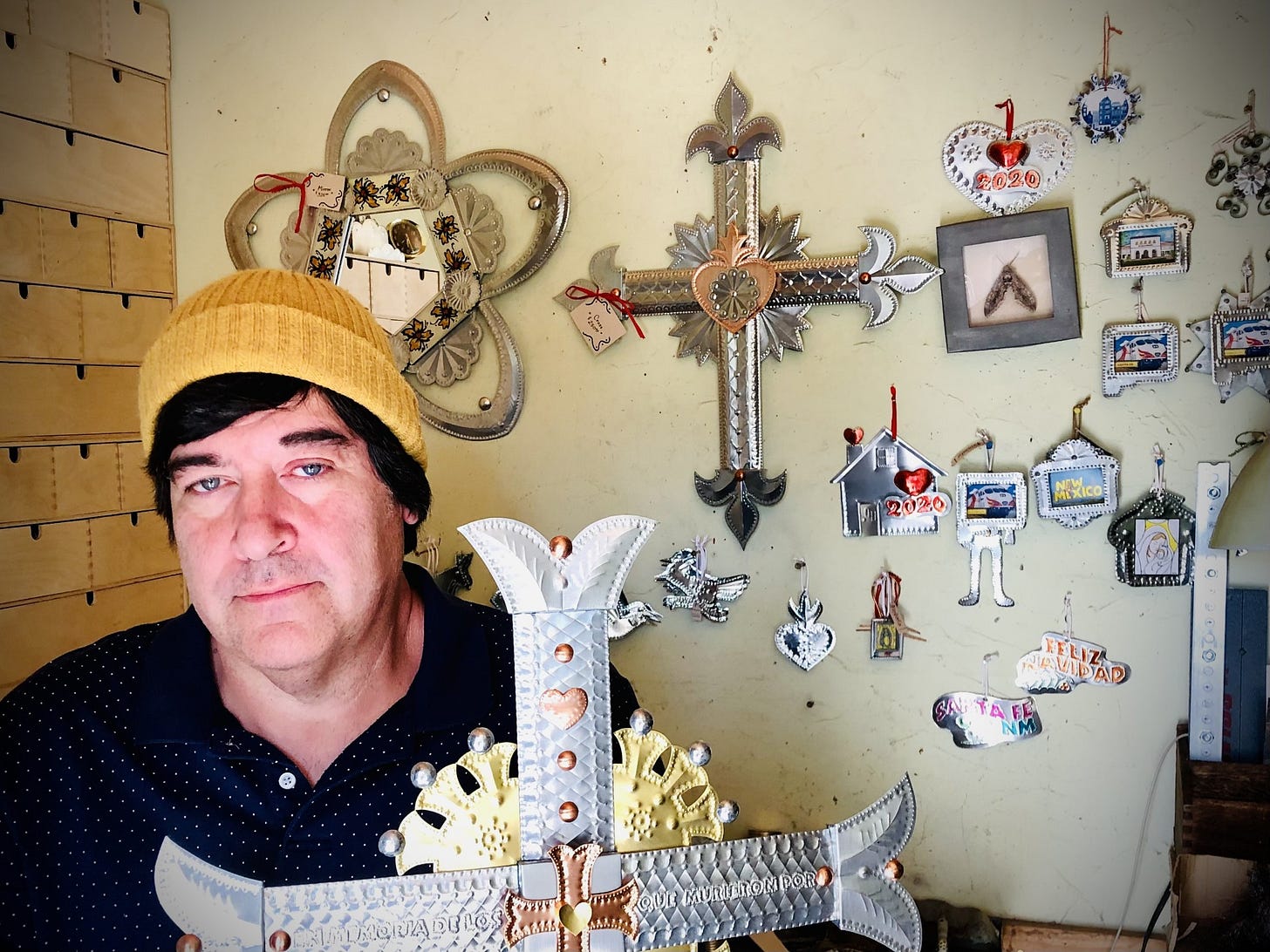
By Brian D’Ambrosio
Glossy and striking, with countless designs of ornamentation, tinwork is a distinct art. In New Mexico, it is especially cherished as a form of expression that is intimately connected to the confluences of its unique history.
As the U.S. Cavalry moved westward on the Santa Fe Trail in the 1840s, it hauled all of life’s necessities for its members. Many of these supply items, such as lantern oil, were stored in tin cans. After the items were transferred or emptied, the giant square tin cans were discarded.
“To the local Hispanic population, it looked like silver,” said Spanish artist and tin worker Richard Gabriel Jr.“It’s not silver. But they realized that they could make beautiful stuff out of it.”
The roots of New Mexico tin, he said,are traceable to Mexico and before that, to Spain, where the Moors introduced it through metalworking.
The earliest tinworkers of New Mexico are mostly anonymous. They didn’t sign their work because more often than not they were making it for the church, and it was considered gauche to invite (and deflect) such attention.
During the Works Progress Administration (WPA) years from 1935 to 1943 - called the “revival period of tin” by Gabriel - the U.S. government encouraged and paid tinsmiths and other artisans to help beautify a host of old and new government buildings. The tin light fixtures still in use at Bandelier National Monument’s visitor center are an example.
Still, the number of artists who work primarily with tin of late is relatively low compared to those engaged in other mediums. Gabriel estimates there are about 20 to 30 tin workers.
For those that do exist, he said, their primary audience is in New Mexico:“Here it is a traditional art, which makes it doubly interesting to people.”
Chances are quite high that if someone owns an example of tinware made in New Mexico, that piece was made by Gabriel.Perhaps the only full-time artist solely dependent on tin for their income, he, like tinwork, comes from a diverse lineage.
Gabriel’s mother’s side of the family, which represents Spanish and Native American cultures, has roots that go back to northeast Mexico, specifically the Monterrey area. His great-grandfather, Marcelino Martinez, was the first mayor of the village of Questa, when it was incorporated. His father, a mix of European heritages, joined the Air Force during the Vietnam War and was sent to Kirtland Air Force Base in Albuquerque. His maternal grandfather taught at Albuquerque High School.
Gabriel and his family moved to Questa when he was a young boy. There, his uncle operated a grocery store, and his grandfather owned a restaurant and motel. For many years, Gabriel worked in the restaurant. When his mother registered for a tinworking class, Gabriel reluctantly joined her at her behest. That was about 34 years ago, when Gabriel was in his 20s. He has been working with tin ever since.
“I’m always teasing my mom, asking her when she is going to finally start her next tinwork project,” he said.
Also an avid painter, Gabriel opened a gallery in Questa in the late 1980s that lasted several years. He later served in the military before finding his forte selling tinware wholesale.
At the peak of his production, Gabriel was creating more than10,000 pieces annually - mostly “bread and butter” ornaments but also more intricate pieces, such as three-dimensional birdhouses and handsomely embellished mirrors, candleholders, and light fixtures.
At one point, he said, his work could be found on sale in about 30 stores, but now he supplies only a few, all in Santa Fe. They include A Christmas Store, Sunwest on the Plaza, and Leslie Flynt.

A resident of Tijeras since the late 1990s, Gabriel teaches tinwork classes at Santa Fe Community College, where he is regarded as a living almanac and instruction manual of the art form.
““I would like to pass it on to as many people as I can to keep it from dying.
“I always tell people that I could teach tin in five minutes,”he said. “Everybody can take a mallet and cut. There are not a lot of steps to remember and very simple tasks. You have to have the right tools to punch. It is not like learning photography. There is no high technical ability."
Perhaps that’s just Gabriel’s soft-spoken, unassuming temperament on display. In truth, tinwork is deceptively challenging, and even the simplest tasks of cutting, punching and scoring requires rapt attention.
Gabriel said that there are two ways of looking at what you can do with tin: You could let your imagination run wild or choose to keep it simple.
“Both are good, and there is room for both,” he said. “It just depends on how involved you want to be. Refining your technique into something special takes time and practice.”
Gabriel works almost exclusively with galvanized steel (as opposed to the more expensive canning tin) and occasionally with a rusty old piece of scrap. For example, he once incorporated the remnants of a 1920s-era sheepherding barn that he found near his home.
While the average person might not be able to detect the nuances that distinguish one tin artist from another, Gabriel can immediately see their unique characteristics. On close inspection, similar patterns reveal subtle variations in the individual impressions, or punches,made by the punch tools that were used.
“Unique punches are made from unique handmade tools,” Gabriel said. “They are not the same exact size or width. If you don’t have the same tools, you can’t replicate that.”



